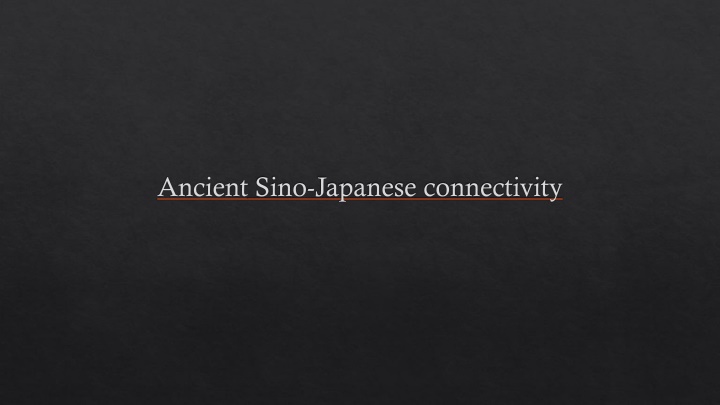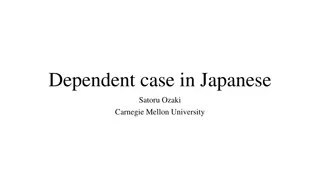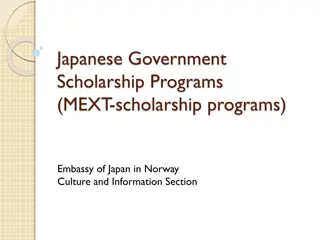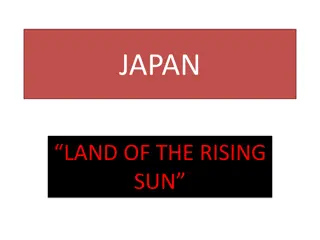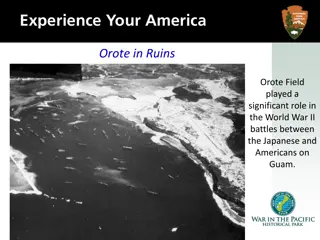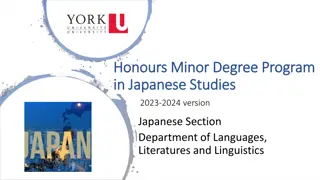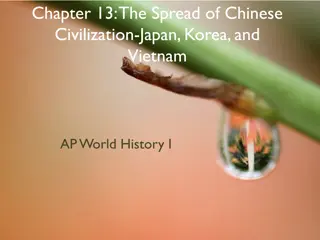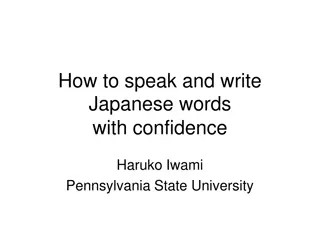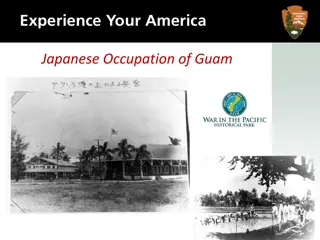Ancient Sino-Japanese Connectivity: From Yayoi Period to Yamato State
In ancient times, the connectivity between Sino-Japanese cultures shaped the emergence of the Yayoi Period and the formation of the Yamato State. The Yayoi Period marked the influx of cultural influences from China and Korea, leading to the development of a new Japanese culture. This culminated in the establishment of the Yamato State, characterized by centralization of power, adoption of Chinese political and cultural models, and the use of monumental tombs to display imperial authority. Factors like the introduction of Buddhism, Sino-Japanese competition, and the divine authority of emperors played crucial roles in shaping the centralization of Yamato imperial power.
Download Presentation

Please find below an Image/Link to download the presentation.
The content on the website is provided AS IS for your information and personal use only. It may not be sold, licensed, or shared on other websites without obtaining consent from the author.If you encounter any issues during the download, it is possible that the publisher has removed the file from their server.
You are allowed to download the files provided on this website for personal or commercial use, subject to the condition that they are used lawfully. All files are the property of their respective owners.
The content on the website is provided AS IS for your information and personal use only. It may not be sold, licensed, or shared on other websites without obtaining consent from the author.
E N D
Presentation Transcript
Yayoi Period and the first connections with China (300 BCE 250 CE) A new culture suddenly emerges in the isle of Honshu (beginning of the Japanese Bronze Age). Above, Yayoi vase, I-III cen. CE Archaeological evidence of the manufacture of bronze, pottery and fine textiles. Possible influence of immigrants from either China or Korea. Bronze bell dotaku , used for ritual purposes, II cen.CE
Towards the formation of the first Japanese state (250 538 CE) The State of Yamato emerges among warring chiefdoms in Central-Southern Japan. Influx of foreigners from nearby Korea and China Progressive establishment of a centralised power ruled by a Great King Chinese politics and culture become Japan s primary model of emulation. This age has been defined Kofun Period , literally Period of the Mounds .
Japanese reception of Chinese idea of rulership As the Yamato state emerged, rulers needed to legiptimise and display their own power (earliest hint of social stratification). For the first time in Japanese history, monumental tombs are employed in the arcipelago to display imperial power. As a result, a huge number of funerary mounds sprang up all around the Yamato state.
Right, Tomb of Emperor Jing of Han (China) Dated to 150s BCE Located outside of Xian. Below, Tomb of (presumably) Queen Himiko of Yamatatiku (Japan) 3 cen. CE 40,000 miniature pottery figurines found inside. Located next to Nara, capital of Yamato. Pottery miniatures depicitng members of her court
What factors contributed to the centralisation of Yamato imperial power? Gradual introduction of Buddhism alongside local Shinto Sino-Japanese agonism: Emphasis on the divine authority of the emperor, supreme guarantor of peace and harmony within the state China represented not only a model to imitate but also a rival to outdo Later on, the emperor Temmu (631- 686 CE) will commission a chronicle to legiptimise the imperial line by claiming a divine heritage.
What is the Wei Zhi (c. 297 CE)? Chinese perception of the Japanese culture and state: the Kingdom of Wa, a focus on the Wei Zhi What is the Kingdom of Wa? What does this say about early Sino- Japanese relations?
The Wei Zhi Also known as the Records of Wei and written as a dynastic history The period of the Three Kingdoms (c. 220-280CE) Most reliable literary source on Japan at the time
The Wa Kingdom Wa here means dwarf and refers to the island of Japan First japanese centralised state: Yamato, under the rule of Queen Himiko (c.170 248 CE) Other ancient source: the Hou Hanshu, the Book of the Later Han (5th century CE)
Sino-japanese relations Japanese first perceived as primitive and inferior Later Yayoi Japan was very deeply agricultural Clear evolution of attitude and approach to foreign politics under Queen Himiko
Case Study- Japanese and Chinese Glass Glass in China is dated to the Warring States Period (475-221BCE) Earliest dates for glass in Japan come form the Yayoi period 3rdC AD No glass making remains found at this time, so likely imported.
Early Chinese Glass contained very high levels of Barium Oxide Similar levels were found in Japanese glass from slightly later periods Roman and Parthian glass in the same period does not have a similar Barium Oxide Content The Content of certain chemicals hints towards both the location of the extraction of the ore and the method in which the glass is produces Main pointer is Barium Oxide Subsidiary chemical markers are Magnesium Oxide and Aluminium Oxide.
Chemical Composition of Glass Samples by Weight (g) Japanese Glass Sample 38 Al2O3 0.35 Fe2O3 0.29 CaO 1.1 BaO 14 MgO 0.15 Na2O 3.9 K2O 0.19 PbO 38.5 CuO 0.78 Ag2O 0.01 Chinese Glass Sample 36 Al2O3 0.36 Fe2O3 0.13 CaO 1.6 BaO 14 MgO 0.16 Na2O 1.65 K2O 0.26 PbO 46.1 CuO 0.88 Ag2O 0.05 SiO2 SiO2
What does this mean? There is clear transfer of technologies between China and Japan. Advent of Glass in China comes 400-700 years prior to Japan. Religion facilitated this transfer. The earliest finds were glass beads used in Buddhist temples. Religious exchange therefore facilitates the spread and adoption of technologies Precedent is set up that technological and religious exchange happens
